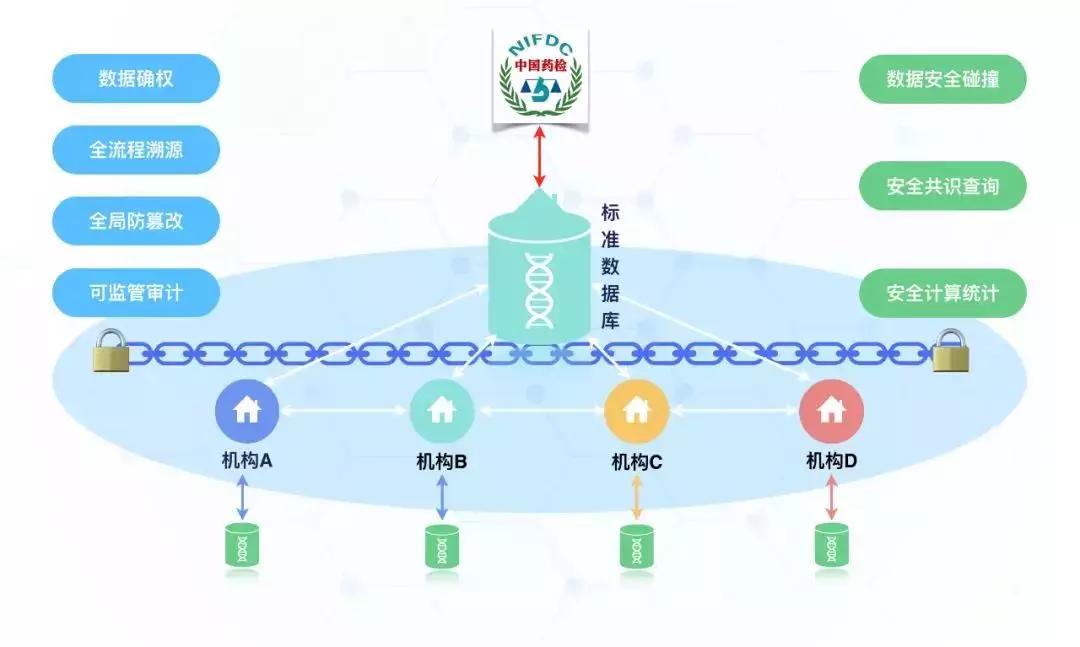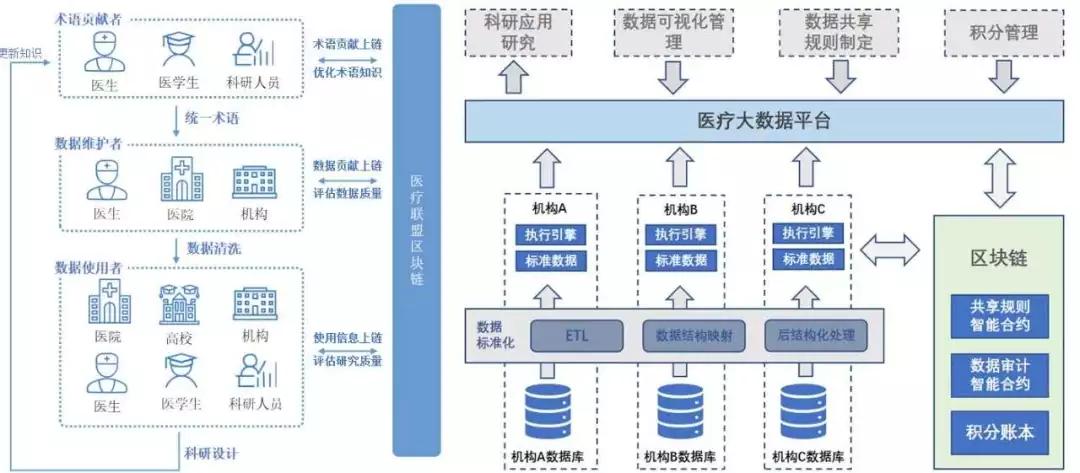Blockchain enters medical deepwater area: Utopia and reality of medical big data

In 2001, the first human genome sketch was completed, which took 13 years and cost 3.8 billion US dollars;
In 2007, the first Chinese genome was completed, which took several months and cost $3 million;
In 2016, an individual completed a genome-wide sequencing in just a few weeks, costing $600 and spending about $70 to get a partial genome report.
- BitMEX CEO: Once Libra is released, it will destroy commercial banks and central banks
- Wall Street giants accelerate the deployment of DeFi, the new financial technology revolution is about to start
- Market Analysis: BTC rebounded sharply in the morning, 10,000 knives are still an important psychological barrier
This is the most intuitive embodiment of technology-enabled medical care and cost reduction. Today, organizations can get more medical data at a lower cost, but data is only really valuable if it is in circulation.
Medical is a typical multi-center scenario where no organization has all the data. As a kind of distributed storage, point-to-point transmission, consensus mechanism, encryption algorithm and other technical combinations, blockchain provides a solution for data sharing. The IBM report believes that by 2020, 56% of medical institutions worldwide will invest in blockchain technology.
However, the promotion of data sharing is not smooth. The difficulty lies not in technology, but in regulation and industry consensus.
First, the medical blockchain: traceability is still the protagonist
In the field of medical blockchain, the most common case of landing is the traceability of medicine.
Record the full process cycle data of the drug on the blockchain system, including pharmaceutical production information, logistics cold chain data, warehouse data, channel sales data, and consumer terminal purchase data. Once the data of each link is entered in the blockchain, it cannot be tampered with.
When a drug problem occurs, the manufacturer and the regulatory authorities can quickly intervene to find out the problem and recall the problem drug. For specific technical solutions for traceability of drugs, see the zinc link previously reported "blockchain + drug traceability, anti-counterfeiting, anti-tampering, Chinese herbal medicines can also be "winding up"."

The only partner of the chain, Qian Chengcheng, told Zinc Link to conduct drug traceability based on the blockchain. In addition to real-time access to drug data and effective supervision, these data can also generate more services, such as pharmaceutical supply chain finance and drug transportation insurance. Wait.
In addition, Qian Chengcheng also introduced the cooperation case with the Norwegian Classification Society (hereinafter referred to as “DNV”) to the Zinc Link. DNV is recognized by the US Medicare and Medicaid Service Center to provide medical care to more than 600 medical institutions in the United States. Management system certification. Drug safety management directly involves patient safety and is a very important part of the system, which is directly related to the application scenario of drug traceability management.
Qian Chengcheng introduced that there are emergency vehicles equipped with medicines, consumables and equipment in the hospital, which need to be manually counted and inspected regularly. However, in reality, due to human error and negligence, drug missed detection often occurs, which will affect the first aid process.

Today, healthcare professionals scan the drug packaging for RFID, chain the drug data, and record timestamps. Since the uplink data cannot be tampered with time stamps, once the equipment of the ambulance is inspected, it can be traced back to the individual who inspected the equipment. "The behavior recorded on the chain cannot be denied."
Qian Chengcheng told Zinc Link that DNV should help the hospital to make a digital transformation. It is one of the starting points for verifying the systemic risk certification of medical institutions by verifying the data of ambulances based on blockchain technology.
Medical care is an industry with a relatively high degree of informatization, and its stock data is already large. Today, blockchains need to break the data silos and give data greater value.
Second, the utopia and reality of medical big data
The industry's vision for the ultimate application of medical big data is that hospitals, pharmaceutical companies, medical devices and scientific research institutions, and individual users will link relevant medical data to form a closed-loop ecology and jointly maintain a book.
Individual users can get accurate medical services because of big data. Organizations can use medical data for scientific research, production, etc., "Who owns who benefits, who uses who pays."
The ideal is full, especially in the context of explosive growth in medical data. IDC predicts that in 2020, the amount of medical data will reach 40 trillion GB, 30 times that of 2010.
According to Xing Haining, Director of Digital Button Technology and Director of Interest Chain Medical Division, Zinc Haining told the zinc link that the domestic medical and pharmaceutical market will reach 10 trillion yuan in 2020.

The reality is very skinny. “The pain is very painful, but the threshold is too high.” This is almost the consensus of practitioners who want to divide the medical blockchain cake. “Privacy Security” and “Data Island” are two major factors that hinder the realization of data value.
Previously, Jiang Wei, Assistant Director of the Center for Chronic Diseases of the Chinese Center for Disease Control and Prevention, said in an interview with the Journal of Chinese Academy of Sciences: "All hospitals have their own data. We pushed the hospital data to open, but for nearly 20 years there has been no Achieve results."
Qian Chengcheng told the zinc link that the hospital's willingness to share data is not high. On the one hand, public hospitals are public resources, and they do not have market-oriented needs, so it is difficult to be impressed by the benefits of data sharing. On the other hand, data sharing brings privacy risks that cannot be controlled.

The Washington Post reported that patient medical data was either sold, transferred, or traded by doctors or medical institutions as part of a $14 billion personal data trading market. As the owner of the data, you will not only be profitable, you may even know nothing about it, and you don’t realize when and where you inadvertently authorized the data to the relevant agencies.
Driven by the benefits of data value, cases of hacking, internal sales of data, and other medical information leaks frequently.
In May 2017, a judgment in Shanghai on the crime of “infringement of citizens’ personal information” showed that two employees of the Shanghai Municipal Center for Disease Control and Prevention and the Huangpu District Center for Disease Control and Prevention jointly seized more than 300,000 pieces of information on newborn babies and sold them. Infant health care products companies to make a profit. Similar cases have emerged in an endless stream.
Third, breakthrough: all parties promote, sharing is the trend
Even if the threshold is high, the medical market is still a tempting cake, and the layout is coming. Data sharing has a huge value space, and as long as you find the entry point, you can open this ten trillion market.
1) Policy support
In August 2015, the State Council issued the “Outline for Promoting Big Data Development”, proposing to “develop medical health service big data and build comprehensive health service applications”.
In June 2016, the General Office of the State Council issued the “Guiding Opinions on Promoting and Regulating the Development of Big Data Applications for Health Care ”, which first raised the health care big data to the national strategic level.
In May of this year, the National Health and Health Commission issued a document continuously, stating that “the hospital data application and management should be regulated, and the health data interconnection of all people should be supported”. This is to promote hospital data sharing from the policy level.
The “Blockchain Technology Helps Chinese Population Genetic Interpretation Standard Database” project is led by China Food and Drug Administration Research Institute, Huada Group's Huada Blockchain BaaS platform provides technical support, Shenzhen Huada Gene Co., Ltd. and other 6 companies Participate in joint construction.
Yang Meng, deputy director of the Greater Data Center of Huada Group, told Zinc Link that the central node (China Food and Drug Control Research Institute) has established node certification, and each testing organization serves as a data source. The alliance organizations jointly formulate data governance rules and write smart contracts.
The original data is still stored in the organization, and the data is parsed and desensitized and uploaded to the central node. Digital signatures, hash summaries for data validation, combined with secure multi-party computing, federal learning and other technologies to ensure data security, "invisible invisible."

This is a project led by a national agency. The goal is to establish a standard reference database for genetic data in the Chinese population, which is also in line with the concept of “shared, shared, and shared” of the national gene bank.
Yang Meng introduced that at present, the first phase of the database has compiled 2843 relevant genetic data of clinical samples, and the number of samples in the second phase has been extended to tens of thousands.
2) Research needs
Xing Haining told Zinc Link that OMAHA research found that the pain of scientific research lies in the lack of sample size and poor data quality. The medical big data platform based on blockchain and community incentive mechanism is the main solution.
“Scientific research is a typical multi-center scene. Different departments of hospitals need data to support scientific research. Only one hospital's data samples are far from enough.” Xing Haining believes that data sharing by scientific research needs is a good entry point. .
Digital Button Technology is the holding company of Fun Chain Technology and Shulan Medical. Its business model is to build the data ecology first, and then provide data to consumers to bring benefits to all parties involved in the ecology. Participants in the medical alliance blockchain include term contributors, data maintainers, and data users.

The term contributor optimizes terminology knowledge and standardizes data. Medical institutions and C-side users are the data sources of the platform, and the contribution data can be scored. When the data is applied to relevant papers and research, the contribution value will be reflected after the results are published.
"The department's attitude toward data sharing is positive for scientific research needs. After the landing case, it will be promoted, and the hospital's acceptance will be higher," Xing Haining said.
3) Privacy protection regulations
Medical data is more valuable and more sensitive.
In 1996, the United States passed the Health Insurance Portability and Responsibility Act. In 2003, the privacy regulations and safety regulations took effect. With the release of the relevant supplemental bill, the United States has developed a privacy and security legal protection system for personal health information.
The Common Data Protection Regulations of the European Union also include personal health care and genetic data.
At present, there are no regulations on medical privacy in China, but the industry is extremely loud.
Qian Chengcheng believes that in the future, with the stricter regulations on privacy and privacy in domestic regulations, medical institutions such as hospitals must obtain authorization from their own personal data. “Data should be owned by the patient and no agency will allow unauthorized use or sale of personal data”.
This trend will force medical institutions such as hospitals to actively distribute data. In fact, the data validation rights that many hospitals are doing are the first step in data sharing.
The boundaries of data protection are still vague, who owns the data and who uses it. Defining the ownership of data is not an easy task. Taking personal medical records as an example, which involves both personal health data and hospital inspection, diagnosis and treatment data, these may be the first consideration for data validation.
In 2017, IBM released a report on healthcare and blockchain, saying that foreign healthcare organizations have adopted blockchain technology and are even more advanced than the financial industry. The report shows that the blockchain will be of great value in clinical trial records, regulatory compliance and medical/health monitoring records.
However, the focus of domestic practitioners is still focused on the financial sector. This has a lot to do with the high threshold of the medical industry. In addition to the professional threshold, the domestic medical industry system is also a mountain. This is a highly regulated and involved industry. Public hospitals control the market share of 85% of medical services.
As mentioned above, companies can open this ten trillion market as long as they find the entry point. In the market that is attractive enough for medical care, more layouts are coming.
Text: Chen Haining
Source: Zinc Link
Editor: The original title is "The blockchain enters the medical deep water area"
We will continue to update Blocking; if you have any questions or suggestions, please contact us!
Was this article helpful?
93 out of 132 found this helpful
Related articles
- Depth | Q coins 17 years of history, what is the enlightenment of Facebook currency?
- Encrypted currency and class crossing (2): the chain of traditional elites is confused, or the opportunity of ordinary people
- Bitfinex: Repaid $100 million in cash to Tether
- Is the XRP breakthrough soon? Ripple invests $500 million only to increase XRP use cases
- The logic of bitcoin's ups and downs
- Getting started with blockchain | What is DApp? Platform without platform
- Bitcoin fell below $10,000, and is still on the train?





